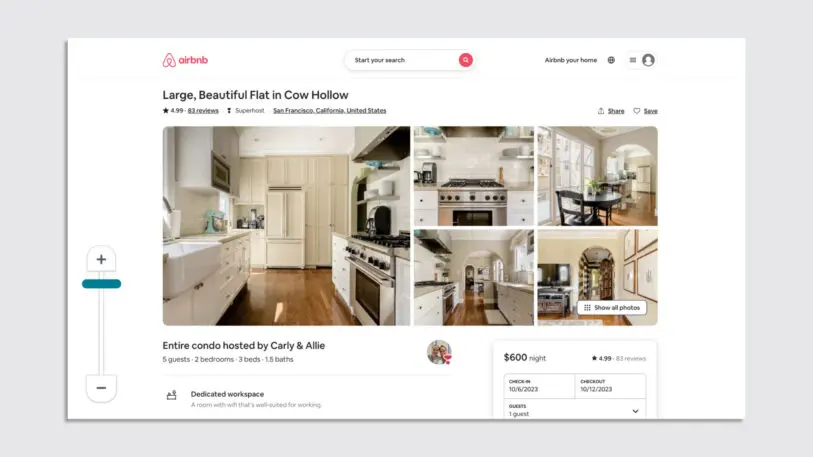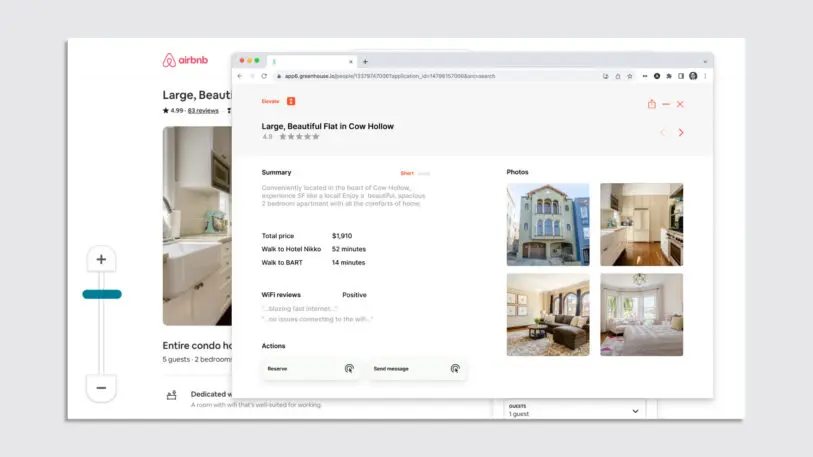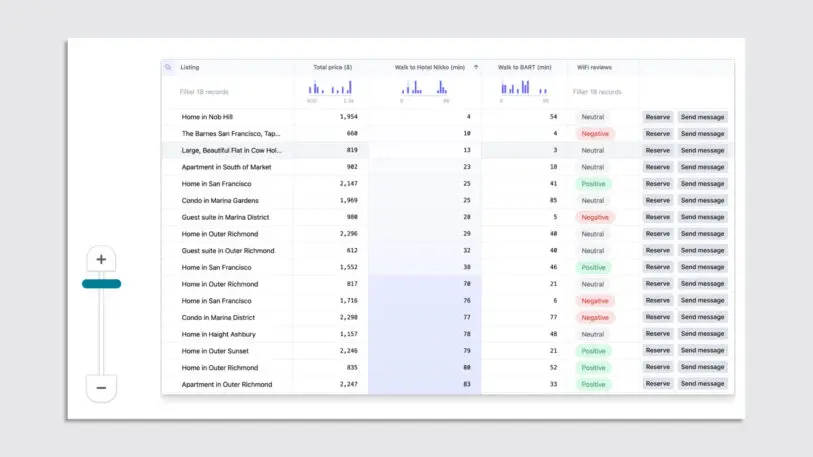Airbnb features a beautiful, functional design. But like any business, it has its own priorities. Airbnb may want to highlight a whimsical home that looks like a giant shoe, while you’re heading out on a work trip and want to find a spot close to the local office that has stable Wi-Fi.
For now, dear user, it’s on you to dig through individual reviews and compare properties in different tabs before squinting at Airbnb’s maps and cross-referencing properties with Google Maps.
But soon? AI could simply rebuild Airbnb’s entire website into exactly what you need it to be—surfacing and presenting the information you care about most.
During a recent presentation at the AI Engineer Summit, a research engineer named Amelia Wattenberger demonstrated software that does exactly that, using the Airbnb redesign as an example (a redesign that is, in fact, a working prototype). Wattenberger specializes in the intersection of design and AI. After helping develop Copilot at Github, she landed at a startup named Adept. With $350 million in series B funding this year, Adept is where dozens of her peers are working with companies to retrofit legacy enterprise software with new, AI-powered UI, while also building a Chrome plug-in that could reshape the web as you know it.
Adept’s uses LLMs (large language models, including ChatGPT) and other multimodal models to actually read what’s on your screen directly. While old automated systems could be scripted to collect certain elements off of web pages, Adept can make out the text, buttons, and images in real time—and they can make sense of what’s on these pages even if their components are moved or redesigned. After processing a page or pages of information, Adept can render an overlay through your web browser that’s like a personalized version of a website or other software.
“The way we go to websites, they’re behind these glass cases,” says Wattenberger. “[The web] is not this interactive place it was kind of meant to be. So, there’s this interesting move toward personalizing, customizing, democratizing websites and interfaces.”
For now, this Airbnb example is but a small taste of how Adept could work with websites and software more broadly. Think of Adept’s AI work like when a fine-dining restaurant presents a protein or vegetable “two ways,” where the core components are largely the same, but the nuance is entirely in presentation.

To start the demonstration, Wattenberger shows us Airbnb’s regular page for a listing in San Francisco. You’ll see all sorts of potentially useful information, like the nightly price, photos, and its star rating.

Adept can scrape this information from Airbnb’s pages, and build new interfaces from it. So, if you communicated your own priorities to the AI—I want to walk to the Hotel Nicco and the BART, and I want listings that have reliable Wi-Fi—the AI models can read Airbnb’s listings to gather that info in minutes—and then place that information on a page generated just for you that’s richer than what Airbnb offers today.
In fact, even tools like messaging the host could go onto this page. Again, this isn’t mere theory—Adept has also developed its own AI models that can handle tasks like outreach and sending emails.
Now, this alone would be pretty handy; reskin Airbnb to be more personalized. But Wattenberger is somewhat obsessed with the UI metaphor of zooming in and out. Like, today, you can zoom into a map, and get more finite detail on restaurants or other attractions in an area. Or you can zoom out to see highways and state lines.
But in the hands of AI, zooming in and out can be more abstract. For instance, if you zoom out on a book, maybe you’d just get a list of chapters. And if you wanted to rewrite any chapter, you could simply change the summary and let the AI do the rest, rather than editing line-by-line as we do today. (In fact, Wattenberger has a side project called PenPal that imagines just this.)
Now, apply that “zoom out” idea to this Airbnb interface instead. What would you do if you could zoom out from your Airbnb custom listing?

Maybe you’d get a spreadsheet, which compares properties side by side based upon your most important criteria. Suddenly, you wouldn’t just see if any single property is nearby a train line; you could see them all.
And what if you wanted to zoom out again?

Maybe you’d see a scatterplot data visualization that weighed walking distance, Wi-Fi, and price to find your most optimal listing. But, and this is pretty key, this data visualization is still actually a working Airbnb interface. Tap onto any dot, or even circle around a group of dots, and you can reach out to the host(s).
“This is where it comes back to democratizing the web,” says Wattenberger. “We don’t have much control of the interfaces we use. And talking to a ton of enterprise use cases, this is rampant in the business world, too, where people are using legacy business software built 10-20 years ago that doesn’t do the things they need to do.”
Rather than rewrite every piece of software, or developing some AI companion that can magically erase the need for most other apps and websites, Adept’s argument is that AI can simply sit atop the software you use today to make it far more accessible. And if this Airbnb redesign is any indication, I’m really going to need Adept to tackle Amazon next.
Recognize your brand’s excellence by applying to this year’s Brands That Matter Awards before the final deadline, June 7.
Sign up for Brands That Matter notifications here.